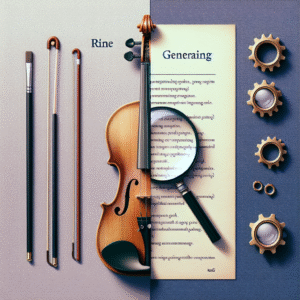Unlocking Creativity: Essential Tips for Designers to Harness Multimodal AI
Table of Contents
Introduction
In today’s whirlwind digital world, the lines between creativity and technology are becoming increasingly fuzzy. Designers are finding themselves in a new landscape where artificial intelligence is part of their everyday toolkit. Enter multimodal AI—these advanced systems can handle and make sense of various types of data like text, images, sounds, and more. This opens up a treasure trove of possibilities for enhancing creative workflows. In fact, a recent survey showed that a whopping 85% of design professionals think AI will have a major impact on their work in just five years.
So, what does this all mean for designers? Is it just another trendy buzzword, or could it actually change the game for how we create? This blog post is here to clear things up about multimodal AI. We’ll dive into the essential tips and tricks you need to start leveraging these technologies right away. Whether you’re looking to grasp the core principles, explore practical applications, or find out about the tools available, this guide is your go-to resource for embracing multimodal AI and supercharging your creativity.
Understanding Multimodal AI
So, what exactly is multimodal AI? In simple terms, it’s the ability of AI systems to process and analyze a variety of data types all at once. That includes things like text, images, audio, and even video. This capability enables a deeper and more sophisticated understanding of information. Unlike the traditional AI that usually sticks to just one type of data, multimodal AI combines multiple inputs for a more rounded perspective.
What Makes Multimodal AI Different?
The standout feature of multimodal AI is its knack for merging different data types into a meaningful analysis. Imagine an AI that can read a product description and then analyze pictures of the product to create a more accurate representation of its features. This multi-layered approach means the AI can handle tasks like image recognition, natural language processing, and sentiment analysis way better than single-modal systems.
Key Components of Multimodal AI
- Data Fusion: This is all about bringing together information from various sources to give a comprehensive view.
- Feature Extraction: It’s about picking out and highlighting the relevant features from different data types to help with decision-making.
- Cross-Modal Learning: This lets AI systems use insights from one type of data to strengthen their understanding in another area.
Why Designers Need Multimodal AI
As design becomes more intricate, having the right tools to streamline tasks and spark creativity is more important than ever. That’s where multimodal AI comes in. It can help designers work smarter and faster by automating repetitive tasks, uncovering valuable insights, and facilitating more dynamic design iterations.
Enhancing Creativity
One of the coolest perks of multimodal AI is its ability to help designers tap into new creative possibilities. By sifting through tons of data, these systems can suggest the latest design trends, recommend color palettes, and even point out typography styles that are hot in the market. This data-driven support can really push designers to think outside the box and explore uncharted creative territory.
Improving Efficiency
We all know time is often in short supply in the design world. Multimodal AI comes to the rescue by automating those mundane tasks like resizing images, generating templates, or even kickstarting initial design concepts. This gives designers more time to focus on the high-level creative work that truly sets their projects apart, leading to innovative results.
Core Principles of Multimodal AI
To make the most out of multimodal AI, designers need to wrap their heads around its fundamental principles. Understanding these concepts will empower them to integrate this technology more effectively into their workflows.
Interconnectivity
Multimodal AI thrives on the connections between different data types. Designers should consider how text, images, and audio can come together to enhance user experiences. For example, a digital marketing campaign could blend videos, social media content, and infographics, all conveying the same message while appealing to a diverse audience.
Context Awareness
Grasping context is vital for impactful design. Multimodal AI can spot patterns and user behaviors across different formats, providing insights into how design elements resonate with audiences. By leveraging this context awareness, designers can craft more targeted and meaningful designs.
Implementing Multimodal AI in Design
Integrating multimodal AI into your design workflow doesn’t have to be overwhelming. With a little strategy, designers can weave these technologies into their processes seamlessly.
Identify Key Areas for AI Integration
Start by pinpointing specific stages in your design process where AI could be a game changer. This could range from brainstorming and concept development to user testing and feedback analysis. By focusing on these critical areas, you can maximize the positive impact of AI on your workflow.
Start Small
It’s tempting to want to overhaul everything at once, but that can lead to chaos. Instead, start with smaller AI tools that can enhance what you’re already doing. For example, you might try an AI tool for color suggestions—it’s a manageable way to dip your toes into the tech without throwing your entire workflow out of balance.
Tools and Technologies to Explore
There are loads of tools and technologies out there that can help designers dive into the world of multimodal AI. Here are a couple of noteworthy options to check out:
Adobe Sensei
Adobe’s AI platform, Sensei, is all about integrating multimodal capabilities across its suite of design tools. It can take care of repetitive tasks, suggest design elements, and analyze user behavior—all in the name of enhancing your creative process.
Canva Magic Write
Canva’s Magic Write feature leverages AI to whip up text-based content based on what you input. This can come in handy for designers aiming to create engaging copy that pairs well with their visuals.
Real-World Case Studies
To give you a better idea of how multimodal AI is being used in the real world, let’s look at a couple of case studies that highlight its effectiveness.
Case Study 1: Nike’s AI-Driven Marketing Campaign
Nike jumped on the multimodal AI bandwagon to analyze social media trends and customer feedback in real-time. By tuning into what their audience cared about, they crafted targeted marketing campaigns that significantly boosted engagement and sales.
Case Study 2: Spotify’s Personalized Playlists
Spotify harnesses multimodal AI to dive into listening habits, user preferences, and even mood-based data to create personalized playlists. This not only enriches the user experience but also keeps users coming back for more.
Challenges and Considerations
While the potential of multimodal AI is enormous, designers should also be aware of the challenges that come with it.
Data Privacy Concerns
Given that AI systems rely on vast amounts of data, it’s crucial for designers to be mindful of data privacy. Ensuring that user data is handled responsibly and ethically should always be a top priority.
Learning Curve
Adopting new technologies often means facing a learning curve. Designers might need to invest some time to really get the hang of how multimodal AI works and how to use it effectively in their day-to-day tasks.
The Future of Design with AI
The future of design is undeniably intertwined with evolving AI technologies. As multimodal AI continues to advance, designers will gain access to increasingly sophisticated tools that can enhance creativity, streamline processes, and elevate user experiences.
Collaborative AI
Looking ahead, we may see multimodal AI focusing more on collaboration. Imagine a future where designers and AI are creative partners, working together to come up with groundbreaking design solutions that blend human intuition with machine intelligence.
Ethical Design Practices
As AI becomes more embedded in design processes, ethical considerations will be crucial. Designers will need to navigate the implications of AI on creativity, representation, and user experience with care and responsibility.
Conclusion
Multimodal AI is an exciting opportunity for designers to enhance their workflows, boost creativity, and improve efficiency. By understanding the core principles, identifying where to integrate AI, and utilizing the right tools, designers can start implementing multimodal AI in their practices today. As the design landscape continues to shift, embracing these technologies will be key to staying ahead in a competitive field. Ready to tap into the potential of multimodal AI? Dive into these tools now and unlock a whole new world of creative possibilities!






